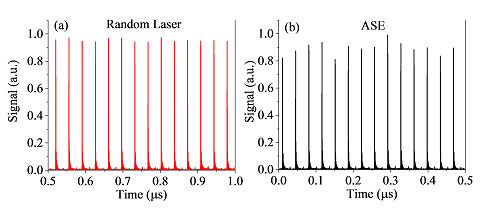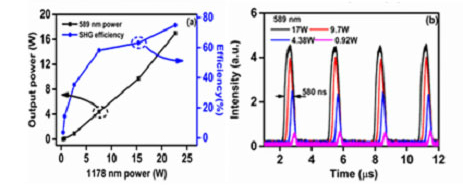[ China Instrument Network Instrument R&D ] Recently, the research group of Shanghai Institute of Optoelectronics, Feng Yan, has made a series of progresses in the study of pulsed Raman fiber lasers.

Raman Dispersion Soliton Output's Spectral Characteristics

Comparison of Random Distributed Feedback Raman Fiber Laser Output and Amplified Spontaneous Emission with Picosecond Pulse Pumping

Lamor Repetitive Pulse 589nm Sodium-semiconductor Laser Output Characteristics
The research group used the amplified spontaneous emission source as a pump to achieve an ultra-stable mode-locked Raman fiber laser output, and used a pulsed laser pump to achieve an ultra-fast random distributed feedback Raman fiber laser output; based on pulsed pumped narrow lines Wide Raman fiber amplifier, successfully developed Larmor's heavy-duty 589nm pulsed yellow laser to increase the brightness of sodium-guided stars.
The primary advantage of Raman fiber lasers with stimulated Raman scattering in the fiber as a gain mechanism is wavelength flexibility. In recent years, the research and development of Raman fiber lasers have been rapid, and the wavelength range has been gradually expanded and the output power can reach several kilowatts. If a high-performance pulsed Raman fiber laser can be obtained, its application range can be further expanded.
The efficiency and stability of the mode-locked Raman fiber laser pumped by continuous wave are much lower than that of the corresponding rare earth-doped fiber laser. As a non-linear gain laser, the pump laser is caused by time-domain fluctuations caused by the longitudinal mode beat frequency, etc., and is directly transmitted to the laser, thereby destroying the stability of the Raman fiber laser. The research group proposes to use a more stable amplified spontaneous emission source in the time domain as a pump. A stable Raman dissipative soliton output with a pulse width of 1 ps is achieved in the 1.1 mm band, and the SNR of the transmitted spectrum is 85 dB. The study was published in [Opt. Lett. 42, 5162 (2017)].
Pulse pumping is an effective means of generating ultrashort pulsed Raman fiber lasers, but pulsed pumping requires real-time feedback control to achieve synchronization of the pump pulse and cavity laser pulse, otherwise it will introduce additional noise in the Raman pulse output. Based on this, the research group proposed a self-synchronization pumping mechanism. This mechanism uses the distributed Rayleigh scattering feedback in the fiber to achieve the self-matching between the laser cavity length and the pump pulse interval, and realizes a picosecond random distributed feedback Raman fiber laser output. Using this pulsed-pumped fiber laser structure, random distributed feedback was directly characterized, and the random laser and amplified spontaneous emission were compared for the first time. The study was published in [Laser Photon.Rev.12, 1700326 (2018)]
Raman fiber laser technology can be used to generate the 589 nm sodium-guided laser needed in astronomical adaptive optics. In order to overcome the influence of the geomagnetic field on the brightness of the sodium guide star, it is necessary to re-frequency about 250-500 kHz (Ramore frequency, depending on the local geomagnetic field strength), and the pulse width is about 20% of the pulsed narrow line width 589 nm laser. The research group used a pulsed 1120 nm laser-pumped narrow-linewidth Raman fiber amplifier to obtain a 1178 nm laser with a desired pulse system. After external cavity resonance frequency multiplication, a 17W Larmor heavy frequency 589 nm sodium guide star laser was obtained. Successfully developed a prototype. The study was published in [Opt. Lett. 42, 4351-4354 (2017)]. Due to the potential application of this laser in remote magnetic field detection, Laser Focus World reported ("Sodium guide star at Larmor frequency extends geomagnetic studies") (January 2018).
(Original Title: Research Progress of Pulsed Raman Fiber Laser from Shanghai Opto-Mechanics Institute)
Bs 3293 Welding Neck Pipe Flanges,Bs Stainless Steel Flanges,Bs 3293 Carbon Steel Flanges,Bs 3293 Slip On Flange
New Century Machinery Co., Ltd , https://www.ncmflange.com